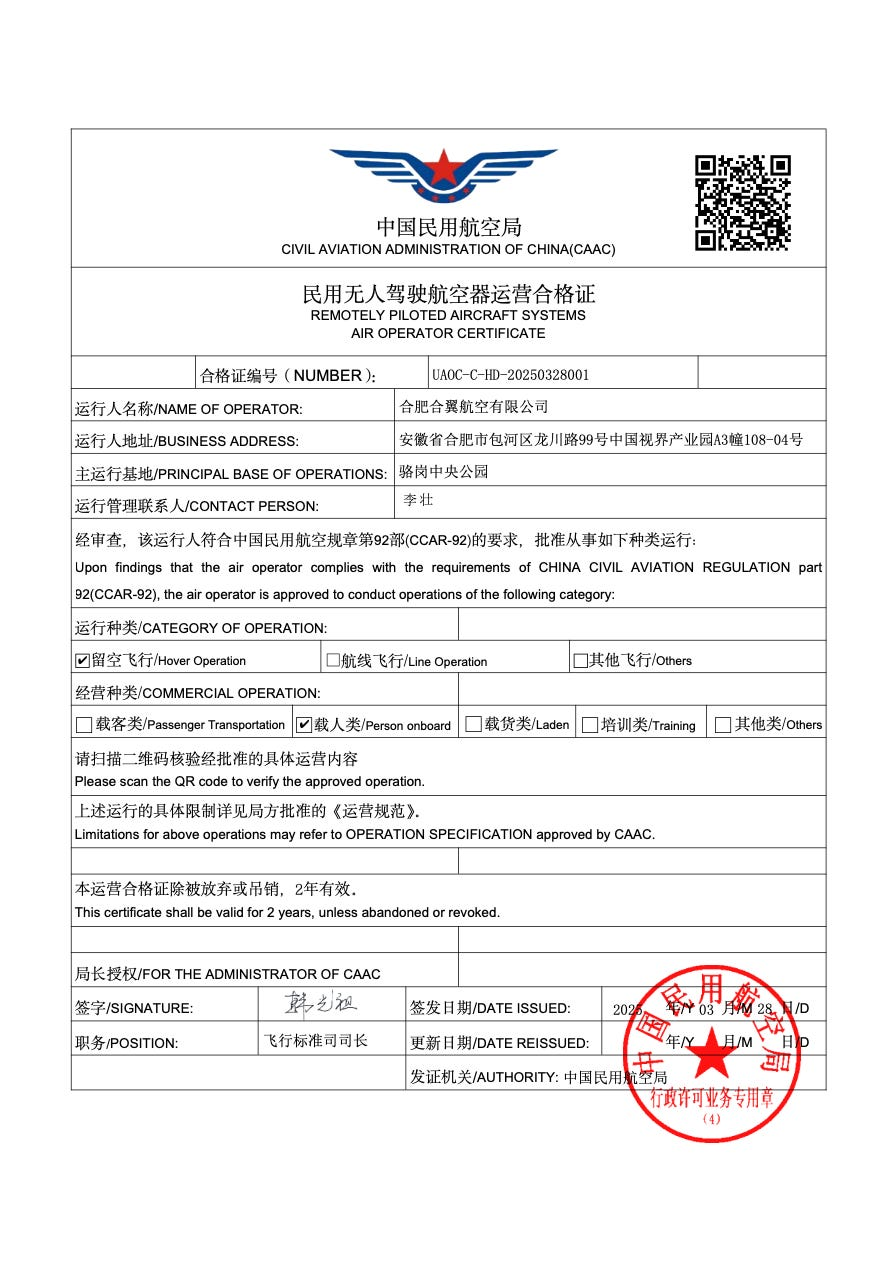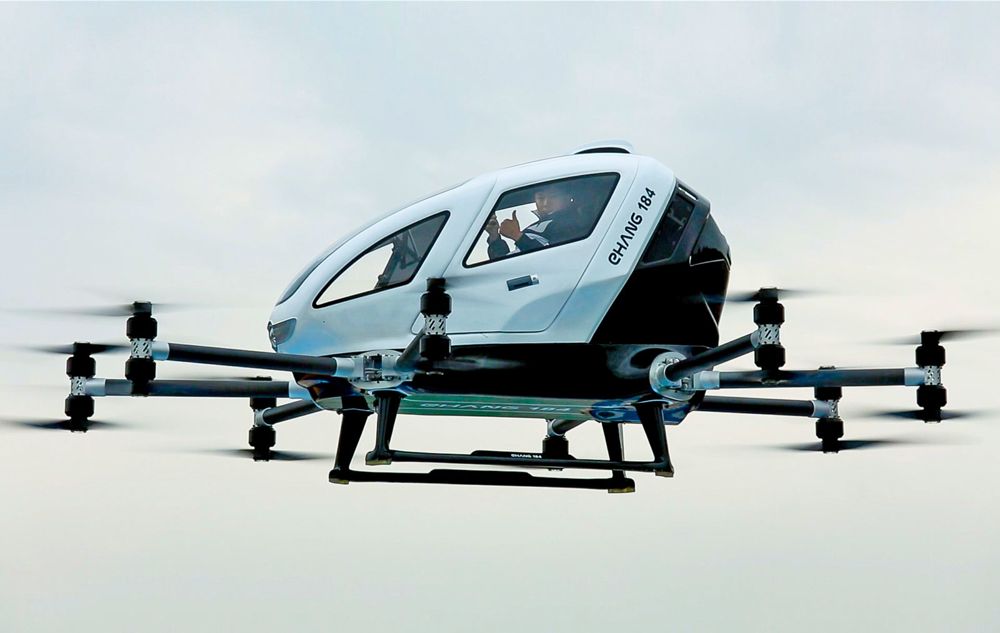EHang recently celebrated a significant milestone as the Civil Aviation Administration of China (CAAC) granted Air Operator Certificates (AOCs) to EHang General Aviation and Heyi Aviation for the EH216-S eVTOL. According to coverage by China eVTOL News, this marks the first time a pilotless, passenger-carrying aerial vehicle has received regulatory approval for commercial operations. It highlights an ongoing shift in how authorities view short-hop electric aircraft and their potential to offer low-altitude tourism, sightseeing excursions, and other services in cities like Guangzhou and Hefei.
Significantly, the AOCs issued to Hefei Heyi Aviation fall under China’s Civil Aviation Regulation Part 92 (CCAR-92)—Rules on the Safety Management of Civil Unmanned Aircraft Operations. These regulations confirm that the EH216-S can be used for sightseeing in Hefei Luogang Park but do not authorize broader urban air mobility services. The certificate, therefore, mandates flights strictly in daytime hours and in normal weather conditions, over sparsely populated areas, and along pre-approved routes in non-controlled airspace, with the EH216-S remaining within visual line of sight. Altitudes cannot exceed 120 meters (about 394 feet), with overall operational altitudes capped below 1,000 meters (approximately 3,281 feet). Point-to-point transportation, beyond visual line of sight (BVLOS) flights, and operations in rain, snow, or at night are also prohibited.

Under these constraints, Hefei Luogang Park provides a controlled environment to refine commercial trial flights, validate safety protocols, and offer restricted public demonstrations. The EH216-S measures roughly 5.6 meters long and wide, standing about 1.7 meters high, and is powered by sixteen electric motors arranged on eight arms. With a payload capacity of 220 to 260 kilograms, it can carry two adult passengers and light luggage, cruising at speeds of up to 100–130 kilometers per hour for 20 to 25 minutes (covering a range of about 30–40 kilometers). Although regulations currently limit flight profiles to short, closed-loop routes, such operations are critical in familiarizing the public and regulators with the technology.
The specific operational classifications in CCAR-92—codified further under Article 92.643—recognize different categories of flight, including “Hovering Flight,” “Route Flight,” and “Other Flights.” Operators can also apply for various business types: Passenger Transport, Passenger-Carrying, Cargo Transport, Training, or Other. According to the Regulations on the Management of General Aviation Business Licensing (CCAR-290-R3), commercial general aviation activities fall under three categories: Passenger Transport (paid point-to-point flights), Passenger-Carrying (non-transport flights like sightseeing), and Other. At present, Hefei Heyi Aviation’s AOC applies to Passenger-Carrying rather than Passenger Transport, underscoring that these scenic flights are not intended for direct travel between two distinct locations.
Despite these limitations, many observers see EHang’s certification under CCAR-92 as a remarkable endorsement of pilotless eVTOL technology. Until now, the CAAC has encouraged aviation innovation, and granting official commercial status to an autonomous aircraft signals a new level of regulatory acceptance. The EH216-S’s extensive testing process, which included demonstration flights and safety evaluations, showed that the vehicle met operational requirements for this specialized form of low-altitude travel. EHang aims to use these early services in Hefei and Guangzhou as testbeds for more expansive implementations over time.
Internationally, EHang has been pursuing certification in other major markets, with a strong focus on Europe. It has collaborated with the European Union Aviation Safety Agency (EASA) since 2020, conducting demonstration flights in Austria, the Netherlands, Spain, and elsewhere. Though not yet fully EASA-certified, these test flights help regulators assess the EH216-S’s stability, autonomous controls, and general safety features. EHang is also positioning the EH216-S for potential introduction to the United States, where the Federal Aviation Administration (FAA) continues refining standards for eVTOL aircraft.
In the short term, the newly granted Air Operator Certificates let EHang and its partners offer low-altitude tourism flights that reinforce public confidence in pilotless aerial travel. As they gain experience under closely monitored conditions, the company will gather data, improve operational practices, and work with local authorities to develop vertiport infrastructure. Over the longer term, these preliminary steps could enable broader UAM services—once regulations permit routes beyond fixed park boundaries and include flights in denser urban corridors. While limitations remain, EHang’s success in securing certification indicates that autonomous, passenger-carrying eVTOLs are steadily moving from a concept to an operational reality in China and, eventually, abroad.

The EH216-S is a two-seat autonomous aerial vehicle for short urban journeys and sightseeing flights. It typically measures about 5.6 meters in length and width, with a height of roughly 1.7 meters. The aircraft’s sixteen electric motors, arranged in pairs on eight arms, provide vertical lift and forward thrust, allowing for precise takeoffs and landings in tightly constrained city environments. EHang targets a maximum payload of around 220 to 260 kilograms, enabling the EH216-S to accommodate two adult passengers and light carry-on items.
Under standard conditions, the EH216-S can reach cruising speeds of approximately 100 to 130 kilometers per hour, though actual performance may vary depending on battery health, environmental factors, and payload weight. Typical flights last 20 to 25 minutes, translating into a point-to-point distance of around 30 to 40 kilometers. The aircraft relies on a battery system designed for rapid charging, with EHang promoting quick turnaround times between flights. Regarding altitude, the EH216-S is intended to operate below 3,000 meters, which meets the general requirements of urban air mobility corridors.




